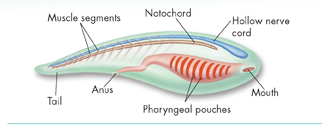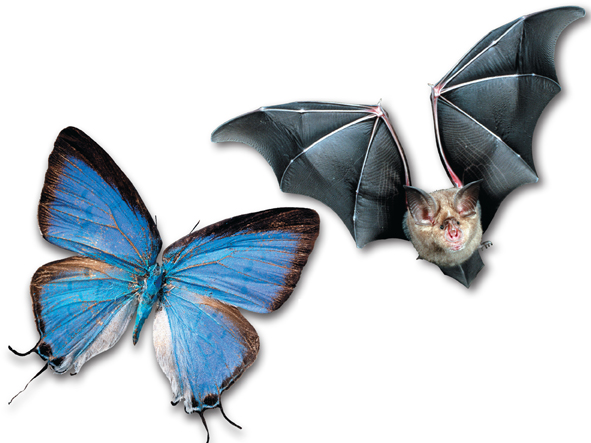
FIGURE 25–1 Characteristics of Chordates All chordates have a dorsal, hollow, nerve cord; a notochord; pharyngeal pouches; and a tail that extends beyond the anus. Some chordates possess all these traits as adults; others possess them only as embryos.
Chordates Fewer than 5 percent of animal species are chordates, members of the clade commonly known as Phylum Chordata.  All chordates exhibit four characteristics during at least one stage of life: a dorsal, hollow nerve cord; a notochord; a tail that extends beyond the anus; and pharyngeal (fuh RIN jee ul) pouches. As you see in Figure 25–1, the hollow nerve cord runs along the dorsal (back) part of the body. Nerves branch from this cord at intervals. The notochord is a long supporting rod that runs through the body just below the nerve cord. Most chordates have a notochord only when they are embryos. At some point in their lives, all chordates have a tail that extends beyond the anus. Pharyngeal pouches are paired structures in the throat region, which is also called the pharynx. In some chordates, such as fishes, slits develop that connect pharyngeal pouches to the outside of the body. Pharyngeal pouches may develop into gills used for gas exchange.
All chordates exhibit four characteristics during at least one stage of life: a dorsal, hollow nerve cord; a notochord; a tail that extends beyond the anus; and pharyngeal (fuh RIN jee ul) pouches. As you see in Figure 25–1, the hollow nerve cord runs along the dorsal (back) part of the body. Nerves branch from this cord at intervals. The notochord is a long supporting rod that runs through the body just below the nerve cord. Most chordates have a notochord only when they are embryos. At some point in their lives, all chordates have a tail that extends beyond the anus. Pharyngeal pouches are paired structures in the throat region, which is also called the pharynx. In some chordates, such as fishes, slits develop that connect pharyngeal pouches to the outside of the body. Pharyngeal pouches may develop into gills used for gas exchange.
Phylum Chordata includes some odd aquatic animals known as nonvertebrate chordates, which lack vertebrae. Most chordates, however, develop a backbone, or vertebral column, constructed of bones called vertebrae (singular: vertebra). Chordates with backbones are called vertebrates. Vertebrates include fishes, amphibians, reptiles, birds, and mammals.  DOL•46–DOL•64
DOL•46–DOL•64
MYSTERY CLUE

Scientists verified that the organisms were young animals that had a stiff rod running along the tail. What does this suggest about the slimy critters?

FIGURE 25–2 Invertebrates and Chordates Both of these animals have fuzzy bodies with wings and both can fly, but the similarities end there. Butterflies are insects, which are invertebrates, and bats are mammals, which are chordates. Classify Bats have backbones. In which of the two major groups of chordates would you classify bats?
Table of Contents
- Formulas and Equations
- Applying Formulas and Equations
- Mean, Median, and Mode
- Estimation
- Using Measurements in Calculations
- Effects of Measurement Errors
- Accuracy
- Precision
- Comparing Accuracy and Precision
- Significant Figures
- Calculating With Significant Figures
- Scientific Notation
- Calculating With Scientific Notation
- Dimensional Analysis
- Applying Dimensional Analysis




